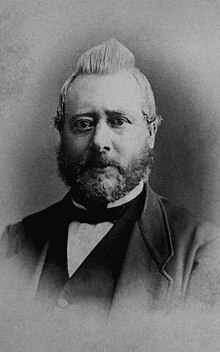Pieter Bleeker
This article includes a list of general references, but it lacks sufficient corresponding inline citations. (August 2011) |
Pieter Bleeker | |
|---|---|
 Pieter Bleeker | |
| Born | 10 July 1819 Zaandam, the Netherlands |
| Died | 24 January 1878 (aged 58) The Hague, the Netherlands |
| Nationality | Dutch |
| Scientific career | |
| Fields | |
| Institutions | Royal Dutch Academy of Sciences National Museum of Natural History (France) Royal Netherlands Institute of Southeast Asian and Caribbean Studies |
Pieter Bleeker (July 10, 1819, Zaandam – January 24, 1878, The Hague) was a Dutch medical doctor, ichthyologist, and herpetologist. He was famous for the Atlas Ichthyologique des Indes Orientales Néêrlandaises, his monumental work on the fishes of East Asia published between 1862 and 1877.
Life and work
Bleeker was employed as a medical officer in the Royal Netherlands East Indies Army from 1842 to 1860,[1] stationed in Indonesia. During that time, he did most of his ichthyology work, besides his duties in the army. He acquired many of his specimens from local fishermen, but he also built up an extended network of contacts who would send him specimens from various government outposts throughout the islands. During his time in Indonesia, he collected well over 12,000 specimens, many of which currently reside at the Natural History Museum in Leiden. Bleeker corresponded with Auguste Duméril of Paris. His work in ichthyology and tropical medicine was recognised by two doctorates honoris causa (Leyden University, 1846; Utrecht University, 1849).[1]
After his return to the Netherlands in 1860, he started publishing the Atlas Ichthyologique des Indes Orientales Néêrlandaises, a comprehensive account of his studies done in Indonesia, featuring over 1,500 illustrations. It was published in 36 volumes between 1862 and his death in 1878.[1] Between 1977 and 1983, the Smithsonian republished the work in 10 volumes.
Bleeker published more than 500 papers on ichthyology, describing 511 new genera and 1,925 new species.
He also worked in herpetology, describing at least 14 species of reptiles,[2][3] most of them described in Reptilien van Agam.[4]
In 1855, he became correspondent of the Royal Netherlands Academy of Arts and Sciences, department Natuurkunde (then Natural Sciences), and in 1862 a member.[5] In 1856 he was elected correspondent for the Muséum national d'histoire naturelle in Paris. In January 1864 he received a French knighthood of the Légion d'honneur.[1] He was president of the Royal Netherlands Institute of Southeast Asian and Caribbean Studies.[6]
References
- ^ a b c d van Heiningen, TW (2010). "[Pieter Bleeker (1819-1878) physician and passionate naturalist]". Hist Sci Med. 44 (3): 257–67. PMID 21560380.
- ^ Bleeker, P (1860). "Over de Reptiliën-fauna van Sumatra". Natuurkundig Tijdschrift voor Nederlandsch Indië. 21: 284–298.
- ^ The Reptile Database
- ^ Bleeker, P. 1860 Reptilien van Agam. Natuurkundig Tijdschrift voor Nederlandsch Indie, Batavia, 20: 325-329
- ^ "Pieter Bleeker (1819 - 1878)". Royal Netherlands Academy of Arts and Sciences. Retrieved 19 July 2015.
- ^ "Pieter Bleeker (1819 - 1878)". Royal Netherlands Academy of Arts and Sciences. Retrieved 19 July 2015.
Further reading
- Beolens B, Watkins M, Grayson M (2011). The Eponym Dictionary of Reptiles. Baltimore: Johns Hopkins University Press. xiii + 296 pp. ISBN 978-1-4214-0135-5. ("Bleeker", p. 28).
- P. Bleeker, Levensbericht in: Jaarboek, 1877, Amsterdam, pp. 5-159 (Autobiography of Bleeker with an introduction by Pieter Harting). (in Dutch).
- Bleeker P, van Oijen MJ, Loots GM, van Limburg FJ (2009). "A precursor of the fish of the Indian Archipelago. Part 1: Siluri". Zoologische Mededelingen. 83: 1–317.
- Norman D, Whitehead PJ (1984). "The Bleeker/Günther letters and the sale of Bleeker specimens to the British Museum". Zoologische Mededelingen. 58: 295–312.
- Whitehead PJ, Boeseman M, Wheeler AC (1966). "The types of Bleeker's Indo-Pacific Elopoid and Clupeoid Fishes". Zoologische Verhandelingen. 84: 1–152.



